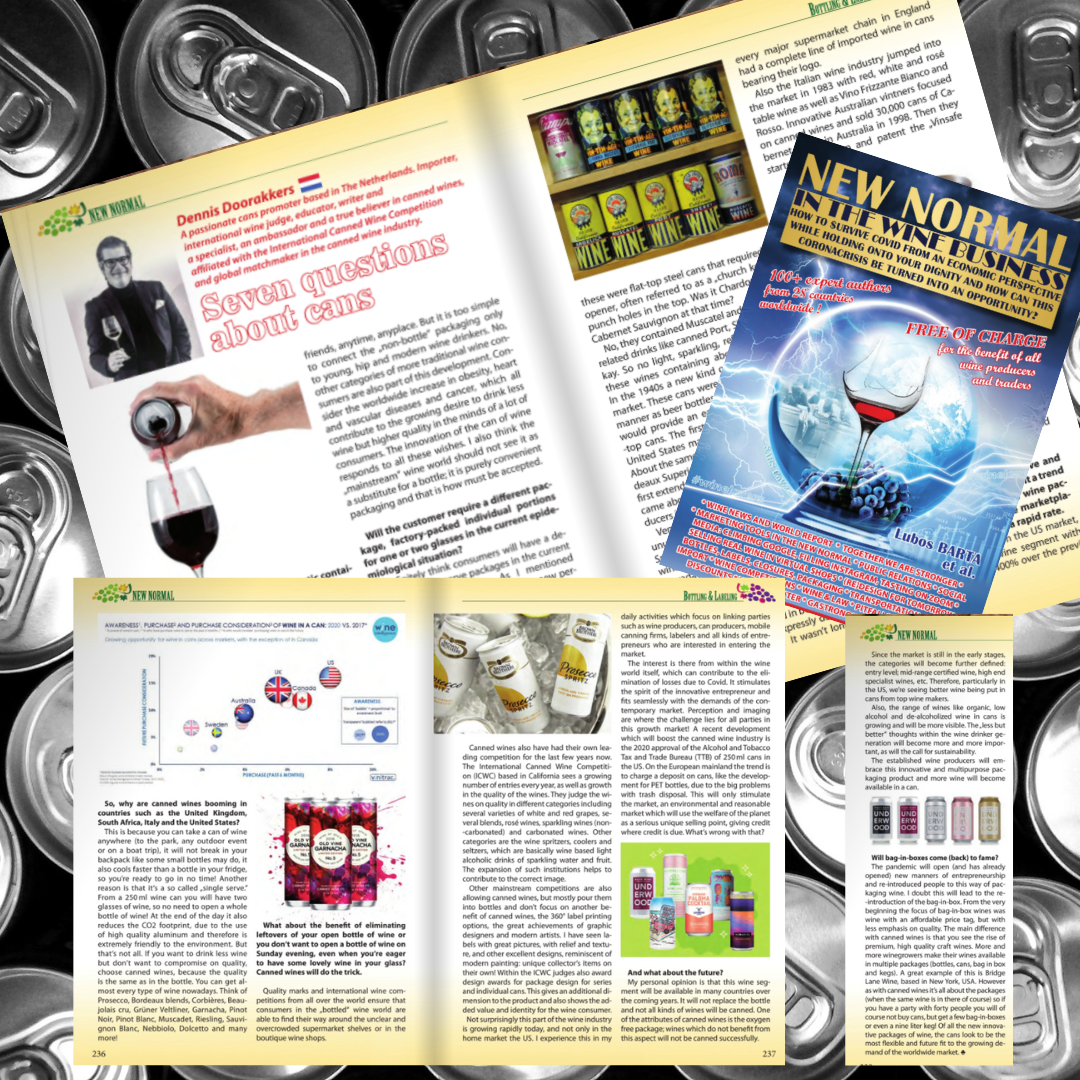Some time ago I was asked by Lubos Bárta (Chief editor E-SOMMELIER Magazine (GastroPress Ltd.), if I wanted to participate in an international publication. As the topic is so important I publish my part again – for the whole publication click on this link.
”𝙉𝙀𝙒 𝙉𝙊𝙍𝙈𝘼𝙇 𝙄𝙉 𝙏𝙃𝙀 𝙒𝙄𝙉𝙀 𝘽𝙐𝙎𝙄𝙉𝙀𝙎𝙎 (𝙤𝙧 𝙃𝙤𝙬 𝙏𝙤 𝙎𝙪𝙧𝙫𝙞𝙫𝙚 𝘾𝙤𝙫𝙞𝙙 𝙁𝙧𝙤𝙢 𝘼𝙣 𝙀𝙘𝙤𝙣𝙤𝙢𝙞𝙘 𝙋𝙚𝙧𝙨𝙥𝙚𝙘𝙩𝙞𝙫𝙚 𝙒𝙝𝙞𝙡𝙚 𝙃𝙤𝙡𝙙𝙞𝙣𝙜 𝙊𝙣𝙩𝙤 𝙔𝙤𝙪𝙧 𝘿𝙞𝙜𝙣𝙞𝙩𝙮 𝘼𝙣𝙙 𝙃𝙤𝙬 𝘾𝙖𝙣 𝙏𝙝𝙞𝙨 𝘾𝙤𝙧𝙤𝙣𝙖 𝘾𝙧𝙞𝙨𝙞𝙨 𝘽𝙚 𝙏𝙪𝙧𝙣𝙚𝙙 𝙄𝙣𝙩𝙤 𝘼𝙣 𝙊𝙥𝙥𝙤𝙧𝙩𝙪𝙣𝙞𝙩𝙮)
Will wine be sold in cans or plastic containers in small individual portions?
Yes, certainly without any doubt and this has already been the case for several years in a lot of countries around the world.
Recent research of the British research firm Wine Intelligence shows that the acceptance of canned wine has grown greatly in the United States, the United Kingdom, Canada and even Sweden. In the current Covid crisis consumers appear to be more open to alternative packaging in wine than ever before. Smaller packages are becoming more popular for multiple reasons. The new generation of wine drinkers is into the experience of drinking quality wine. They want to drink wine with friends, anytime, anyplace. But it is too simple to connect the ‘non-bottle’ packaging only to young, hip and modern wine drinkers. No, other ‘categories’ of more traditional wine consumers are also part of this development. Consider the worldwide increase in obesity, heart and vascular disease and cancer, which all contribute to the growing desire to drink less wine but higher quality in the minds of a lot of consumers. The innovation of the can of wine responds to all these wishes. I also think the ‘mainstream’ wine world should not see it as a substitute for a bottle; it is purely convenient packaging and that how is must be accepted.
Will the customer require a different package, factory-packed individual portions for one or two glasses in the current epidemiological situation?
I definitely think consumers will have a demand for ‘single serve’ packages in the current epidemiological situation. As I mentioned before this current pandemic opens new perspectives and sometimes forces producers and consumers alternative packaging in wine than ever before.
But is the wine can really that new and contemporary?
Let me take you briefly into the history of wine in a can. The first experiments with canned wine paralleled the introduction of the first beer cans in 1935 in the United States. These were not the ‘tab’ cans that we are used to these days; these were flat-top steel cans that required an opener, often referred to as a “church key,” to punch holes in the top. Was it Chardonnay or Cabernet Sauvignon at that time? No, they contained Muscatel and other wine related drinks like canned Port, Sherry and Tokay. So no light, sparkling, refreshing wines; these wines containing about 20% alcohol. In the 1940s a new kind of can came on the market. These cans were opened in the same manner as beer bottles and it was hoped they would provide an easier transition than flat-top cans. The first wine canned outside the United States may have been from Australia. About the same time a French steel can of Bordeaux Superieur appeared on the market. The first extended marketing of white wine in cans came about in the late 1970s courtesy of producers in Australia. Venezuela and Argentina followed with unusual canned wines based on red wine of Spain with citrus fruit juices added – like the wine spritzers, coolers and seltzers we have nowadays!
In 1981 aluminum cans were introduced in England, specifically a French vin de table specially selected for the can. Within one year, a redesigned tall 250 ml can, was introduced and wines were imported in bulk to be canned in England or in cans expressly designed and filled for the producer. It wasn’t long before every major supermarket chain in England had a complete line of imported wine in cans bearing their logo. Also the Italian wine industry jumped into the market in 1983 with red, white and rosé table wine as well as Vino Frizzante Bianco and Rosso. Innovative Australian vintners focused on canned wines and sold 30,000 cans of Cabernet Shiraz in Australia in 1998. Then they started to develop and patent the ‘Vinsafe canning technology,” which assures stability of premium varietal wines and a shelf life of at least five years. Their 250 ml. cans are distributed in Asia, Europe, Canada, New Zealand and Australia.
But what about today’s perspective and the near future of canned wines? Is it a trend that will pass or will this form of wine packaging get its own place in the marketplace? The market is growing at a rapid rate.
To quote some figures from the US market, it is the fastest growing wine segment with a growth percentage of 400% over the previous 4 four years.
So, why are canned wines booming in countries as the United Kingdom, South Africa, Italy and the United States? This is because you can take a can of wine anywhere (to the park, any outdoor event or on a boat trip), it will not break in your backpack like some small bottles may do, it also cools faster than a bottle in your fridge, so you’re ready to go in no time! Another reason is that it’s a so called “single serve.” From a 250 ml wine can you will have two glasses of wine, so no need to open a whole bottle of wine! At the end of the day it also reduces the CO2 footprint, due to the use of high quality aluminum and therefore is extremely friendly to the environment. But that’s not all. If you want to drink less wine but don’t want to compromise on quality, choose canned wines, because the quality is the same as in the bottle. You can get almost every type of wine nowadays. Think of Prosecco, Bordeaux blends, Corbières, Beaujolais cru, Gruner Veltliner, Grenacha, Pinot Noir, Pinot Blanc, Muscadet, Riesling, Sauvignon Blanc, Nebbiolo, Dolcetto and many more! What about the benefit of eliminating leftovers of your open bottle of wine or you don’t want to open a bottle of wine on Sunday evening, even when you’re eager to have some lovely wine in your glass? Canned wines will do the trick.
Quality marks and international wine competitions from all over the world ensure that consumers in the ‘bottled’ wine world are able to find their way around the unclear and overcrowded supermarket shelves or in the boutique wine shops.
Canned wines also have had their own leading competition for the last few years now. The International Canned Wine Competition (ICWC) based in California sees a growing number of entries every year, as well as growth in the quality of the wines.
They judge the wines on quality in different categories including several varieties of white and red grapes, several blends, rosé wines, sparkling wines (non-carbonated) and carbonated wines. Other categories are the wine spritzers, coolers and seltzers, which are basically wine based light alcoholic drinks of sparkling water and fruit. Theexpansion of such institutions helps to contribute to the correct image.
Other ‘mainstream’ competitions are also allowing canned wines, but mostly pour them into bottles and don’t focus on another benefit of canned wines, the 360° label printing options, the great achievements of graphic designers and modern artists. I have seen labels with great pictures, with relief and texture, and other excellent designs, reminiscent of modern painting: unique collector’s items on their own! Within the ICWC judges also award design awards for package design for series and individual cans. This gives an additional dimension to the product and also shows the added value and identity for the wine consumer.
Not surprisingly this part of the wine industry is growing rapidly today, and not only in the ‘home market’ the US. I experience this in my daily activities which focus on linking parties such as wine producers, can producers, mobile canning firms, labelers and all kinds of entrepreneurs who are interested in entering the market.
The interest is there from within the wine world itself, which can contribute to the elimination of losses due to Covid. It stimulates the spirit of the innovative entrepreneur and fits seamlessly with the demands of the contemporary market. Perception and imaging are where the challenge lies for all parties in this growth market! A recent development which will boost the canned wine industry is the 2020 approval of the Alcohol and Tobacco Tax and Trade Bureau (TTB) of 250 ml cans in the US. On the European mainland the trend is to charge a deposit on cans, like the development for PET bottles, due to the big problems with trash disposal. This will only stimulate the market, an environmental and reasonable market which will use the welfare of the planet as a serious unique selling point, giving credit where credit is due. What’s wrong with that?
And what about the future?
My personal opinion is that this wine segment will be available in many countries over the coming years. It will not replace the bottle and not all kinds of wines will be canned. One of the attributes of canned wines is the oxygen free package; wines which do not benefit from this aspect will not be canned successfully.
Since the market is still in the early stages, the categories will become further defined: entry level; mid-range certified wine, high end specialist wines, etc. Therefore, particularly in the US, we’re seeing better wine being put in cans from top wine makers.
Also, the range of wines like organic, low alcohol and de-alcoholized wine in cans is growing and will be more visible. The ‘less but better’ thoughts within the wine drinker generation will become more and more important, as will the call for sustainability.
The established wine producers will embrace this innovative and multipurpose packaging product and more wine will become available in a can.
Will bag-in-boxes come (back) to fame?
The pandemic will open (and has already opened) new manners of entrepreneurship and re-introduced people to this way of packaging wine. I doubt this will lead to the re-introduction of the bag-in-box. From the very beginning the focus of bag-in-box wines was wine with an affordable price tag, but with less emphasis on quality. The main difference with canned wines is that you see the rise of premium, high quality craft wines.
More and more winegrowers make their wines available in multiple packages (bottles, cans, bag in box and kegs). A great example of this is Bridge Lane Wine, based in New York, USA. However as with canned wines it’s all about the packages (when the same wine is in there of course) so if you have a party with forty people you will of course not buy cans, but get a few bag-in-boxes or even a nine liter keg! Of all the new innovative packages of wine, the cans look to be the most flexible and ‘future fit’ to the growing demand of the worldwide market.




